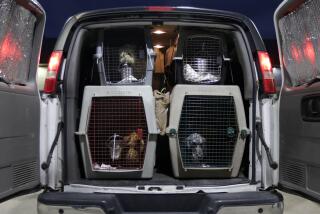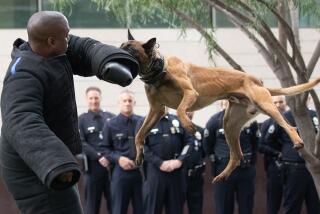Law With Bite to It : Police Department’s K-9 Unit Sinks Its Teeth Into Dangerous Work of Search and Capture
- Share via
Kerry Anderson stood menacingly on the lawn, waving a stick and wearing a thick, padded sleeve on his left arm.
Officer John Hall kept his 4-year-old rottweiler, a female named Liberty, at bay. She stayed at his side impatiently, her muscles tensed in anticipation of the command to attack. Finally, it came.
“Get him!” Hall said.
Liberty raced across the lawn and leaped, a 95-pound cannonball of muscle and fur and teeth. The burly Anderson, almost knocked to the ground on impact, tried to shake off the jaws that clamped his sleeve like spiked handcuffs.
“Liberty, off!” Hall commanded.
Reluctantly, Liberty let go and trotted back to her handler. She knew, of course, that Officer Anderson was really one of the boys; this was just a demonstration, and biting anywhere but the sleeve was a no-no.
Special Unit
Liberty is one of 15 canine members of the Los Angeles Police Department’s K-9 Unit, which for the last eight years has been giving new meaning to the slogan: “Take a Bite Out of Crime.”
Since 1980, when approval was given to train two search dogs for a pilot program, the K-9 Unit has grown steadily in size and status, gaining recognition as an important arm of law enforcement.
What is unusual about the LAPD’s K-9 Unit is that all dogs are bought with private contributions. Los Angeles is one of the few cities in the country not paying for its own police dogs, which cost about $2,500 each.
Instead, the money is raised by the West Los Angeles Boosters Assn., a group of business and professional donors formed in 1972 to sponsor youth programs. The group became involved in the police dog program in 1980 after hearing that the city would not finance the purchase of dogs.
Based in the West Los Angeles area police station at 1663 Butler Ave., the association has 260 members, most from the Westside, who donate $25, $50 or $100 a year to support youth programs and to buy dogs.
Boosters President Harriet Moffat, 80, has always been a dog lover. She reminisced about police dogs that have come and gone over the years as if they were her grandchildren, boasting of their talents and grieving at their passing.
A rottweiler named Jake would push people aside at the water fountain to get a drink himself, pushing the button with his paw. “People couldn’t believe it,” she said.
If somebody was using the office change machine, Jake would look at him with imploring eyes. Then he would stand next to the cookie machine, his expression dead serious.
“People knew they weren’t supposed to give him anything,” Moffat said. “But they did.”
Last November, Moffat accompanied the head trainer of the K-9 Unit, Donn Yarnall, to West Germany, where the unit buys most of its dogs because of the quality breeding and comparatively low prices.
Moffat learned to speak some German, which proved useful with dogs that understood nothing else.
“When a new dog comes in, I say, ‘oh, liebchen ,’ which means ‘darling’ in German, and he comes right over and kisses me,” she said. “I get my face washed every time I see one.”
On their arrival at Los Angeles International Airport, the dogs were taken out of the hold and one bounded across the runway, she said. Yarnall gave one command: “ Nein !”
“That dog stopped and came right back over,” Moffat said. “Then he put his paws up on Donn’s shoulders as if to say, ‘I’m a good doggie, I just wanted out of that cage.’ ”
Lost Lives
Moffat also remembered the dogs that lost their lives in the line of duty.
Richter was a rookie, a 3-year-old German shepherd that had been on the force only a few months. He was stabbed to death a year ago by a burglar he had located inside a warehouse. Richter kept attacking even as he sustained the fatal wounds.
Six years before, a dog named Rooster fell seven stories to his death while searching a rooftop. Wanting to look on the other side of an air-conditioning unit, he jumped over a low wall that, in fact, was the edge of the roof.
But danger comes with the turf for K-9 teams, which are deployed only for felonies or misdemeanors involving a gun. They are dispatched to situations in which a suspect has eluded police on foot or is known to be hiding in the vicinity.
Using dogs cuts costs and man-hours, and in some situations, one animal can do the work of a dozen men, said Lt. Dick Bonneau, the officer in charge of the unit.
If a man is hiding inside a large building, he said, police first establish a perimeter from which they watch all exits. That may take several cars.
Then a police team is sent in to search. Human officers have to look everywhere because they rely on their eyes. Dogs can go straight to the hidden man because they track by smell.
Careful Selection
In selecting dogs for the unit, Bonneau said, character and temperament are carefully considered, and dogs that are too vicious are rejected.
“They look for dogs that have the character to search when you want them to search,” he said. “When it’s time to work, we work. When it’s time to be around people, we do that, too.”
Unlike Liberty, the other 14 dogs in the unit are all German shepherds and all males.
Some dogs purchased for the unit have already graduated from rigorous German training schools, where they have learned obedience, protection, control, directed searching, tracking, agility and retrieving. The foreign-trained dogs respond to German commands.
But regardless of previous experience, every dog and handler go through a 14-week training program run by head trainer Yarnall. In some cases, this is a simple review for the dog and a crash course for the handler.
The handler’s training is just as important as the dog’s, Yarnall said. Each dog knows one master, responding only to the commands of its handler, and the two must work together like veteran partners.
In protection training, dogs learn to attack on command. Trainers become mock criminals, wearing $800 protective body suits to teach the dogs to bite anywhere on the body--not just the arm.
Dogs also learn to find and hold someone by running up and barking, not attacking unless the suspect attacks first or tries to run away.
Tracking By Smell
Eventually, the dogs are trained to track by smell, putting to work a sense hundreds of times keener in dogs than humans.
“Everybody who runs from the police emits what is called a fear scent,” Yarnall said. “This is based on the fight-or-flight syndrome.”
A combination of Adrenalin, amino acids and butyric acids--chemical compounds people secrete in fearful situations--make a scent that the dogs are trained to home in on.
“The dog assumes that every time he smells this particular scent, there is a criminal at its source,” Yarnall said. Most of the time, the “fear scent” allows the dog to distinguish between the criminal and backup officers or bystanders.
If a police officer has been shot at, Yarnall said, he, too, may be emitting the scent and may have to be removed from the scene.
“We can tell immediately when the dog picks the scent up,” Yarnall said. “His demeanor will change, his body posture will change, and he will give an alert to the suspect’s scent.”
In most situations, a dog is commanded to search until it finds, then bark and hold the person in place. If the suspect tries to flee or hurt the dog, it is trained to attack without command.
3 to 5 Captures
“If the suspect is there, the dog will find him,” Yarnall said. He estimated that 30% of all searches result in a capture, and that each dog makes three to five captures per week.
“These dogs are self-motivated,” said Sal Apodaca, a handler whose 7-year-old shepherd, Marko, has made 158 captures. “That dog is not searching for you, he’s searching for himself.”
“It’s not work to them,” said Hall, Liberty’s handler. “It’s a game.”
Hall gave Liberty the command to “find,” and the dog flew across the lawn. She threw on the brakes inches from Anderson’s shins and barked ferociously, jumping up and down as if an invisible barrier stood between them. Then Hall called her off.
Looking disappointed that Anderson hadn’t tried to run, Liberty knew she had to obey the command. But before leaving him, she reached up and gave him one good nip on the padded sleeve.
Just to let him know who was boss.
More to Read
Sign up for Essential California
The most important California stories and recommendations in your inbox every morning.
You may occasionally receive promotional content from the Los Angeles Times.










